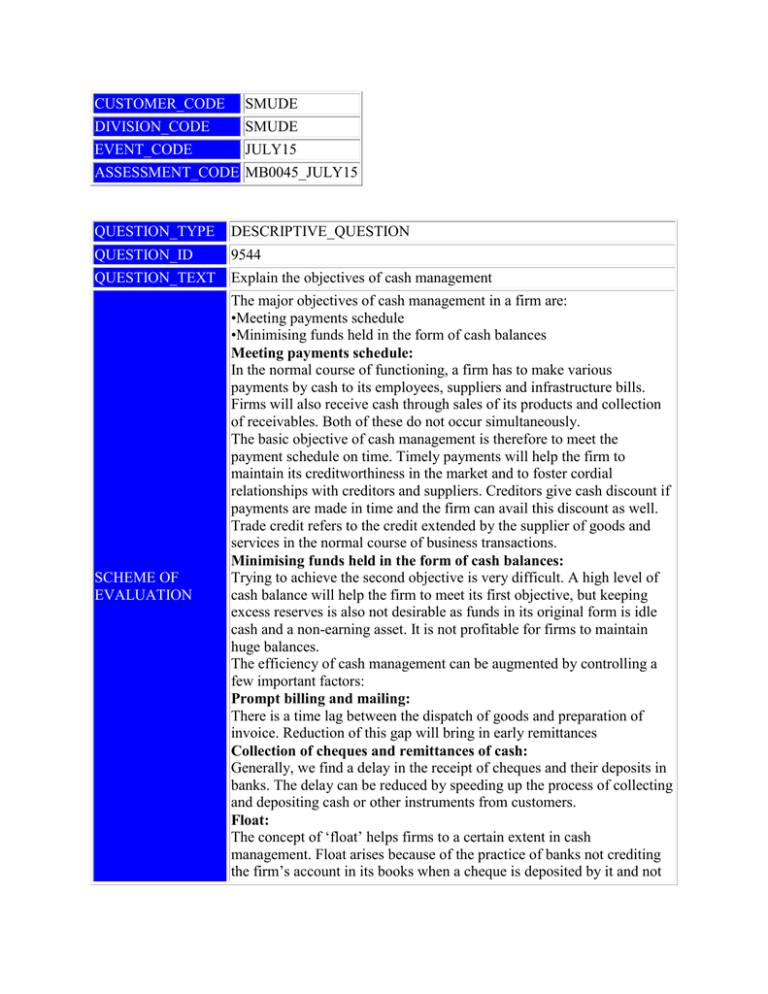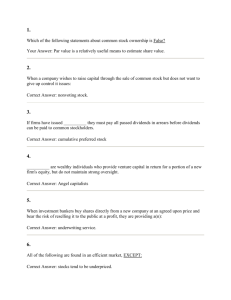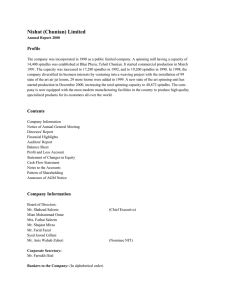CUSTOMER_CODE SMUDE DIVISION_CODE SMUDE
advertisement

CUSTOMER_CODE SMUDE DIVISION_CODE SMUDE EVENT_CODE JULY15 ASSESSMENT_CODE MB0045_JULY15 QUESTION_TYPE DESCRIPTIVE_QUESTION QUESTION_ID 9544 QUESTION_TEXT Explain the objectives of cash management SCHEME OF EVALUATION The major objectives of cash management in a firm are: •Meeting payments schedule •Minimising funds held in the form of cash balances Meeting payments schedule: In the normal course of functioning, a firm has to make various payments by cash to its employees, suppliers and infrastructure bills. Firms will also receive cash through sales of its products and collection of receivables. Both of these do not occur simultaneously. The basic objective of cash management is therefore to meet the payment schedule on time. Timely payments will help the firm to maintain its creditworthiness in the market and to foster cordial relationships with creditors and suppliers. Creditors give cash discount if payments are made in time and the firm can avail this discount as well. Trade credit refers to the credit extended by the supplier of goods and services in the normal course of business transactions. Minimising funds held in the form of cash balances: Trying to achieve the second objective is very difficult. A high level of cash balance will help the firm to meet its first objective, but keeping excess reserves is also not desirable as funds in its original form is idle cash and a non-earning asset. It is not profitable for firms to maintain huge balances. The efficiency of cash management can be augmented by controlling a few important factors: Prompt billing and mailing: There is a time lag between the dispatch of goods and preparation of invoice. Reduction of this gap will bring in early remittances Collection of cheques and remittances of cash: Generally, we find a delay in the receipt of cheques and their deposits in banks. The delay can be reduced by speeding up the process of collecting and depositing cash or other instruments from customers. Float: The concept of ‘float’ helps firms to a certain extent in cash management. Float arises because of the practice of banks not crediting the firm’s account in its books when a cheque is deposited by it and not debiting the firm’s account in its books when a cheque is issued by it, until the cheque is cleared and cash is realized or paid respectively. QUESTION_TYPE DESCRIPTIVE_QUESTION QUESTION_ID 9546 QUESTION_TEXT Discuss the different forms of dividend SCHEME OF EVALUATION Cash Dividend: Most companies pay dividends in cash. The investors also, especially the old and retired investors, depend on this form of payment for want of current income. Scrip dividend: In this form of dividend, equity shareholders are issued transferable promissory notes with shorter maturity periods, which may or may not bear interest. This form is adopted if the firm has earned profits and it will take some time to convert its assets into cash. Payment of dividend in this form is done only if the firm is suffering from weak liquidity position. Bond dividend: Scrip and bond dividend are the same, except that they differ in terms of maturity. Bond dividends carry longer maturity periods and bear interest, whereas scrip dividends carry shorter maturity periods and they may or may not carry interest. Stock dividend( bonus shares): Stock dividend, as known as USA or bonus shares, as known in India, is the distribution of additional shares to the shareholders at no additional cost. This has the effect of increasing the number of outstanding shares of the firm. The reserves and surplus are capitalized to give effect to bonus issue. This decision has the effect of recapitalization, that is, transfer from reserves to share capital and not changing the total net worth. The investors are allotted shares in proportion to their present shareholding. Declaration of bonus shares has a favourable psychological effect on investors. They associated it with prosperity. QUESTION_TYPE DESCRIPTIVE_QUESTION QUESTION_ID 9547 QUESTION_TEXT What is capital budgeting decision? Highlight its types SCHEME OF EVALUATION Meaning of capital budgeting: Capital budgeting is a blue–print of planned investments in operating assets. Thus, capital budgeting is the process of evaluating the profitability of the projects under consideration and deciding on the proposal to be included in the capital budget for implementation. Types: ●Decision to replace the equipments for maintenance of current level of business or decisions aiming at cost reductions, known as replacement decisions ●Decisions expansion through improved network of distribution or on expenditure for increasing the present operating level ●Decisions for production of new goods or rendering of new services ●Decisions on penetrating into new geographical area ●Decisions to comply with the regulatory structure affecting the operations of the company, like investments in assets to comply with the conditions imposed by Environmental Protection Act ●Decisions on investment to build township for providing residential accommodation to employees working in a manufacturing plant QUESTION_TYPE DESCRIPTIVE_QUESTION QUESTION_ID 73182 QUESTION_TEXT What is financial management? Explain the functions of finance? SCHEME OF EVALUATION Financial management of a firm is concerned with procurement and effective utilisation of funds for the benefit of its shareholders. It is the art and science of managing money. 2M Finance functions 1. Financing decisions 2. Investment decisions 3. Dividend decisions 4. Liquidity decisions 2M each with explanation QUESTION_TYPE DESCRIPTIVE_QUESTION QUESTION_ID 125904 QUESTION_TEXT Explain the concepts of working capital. a. b. SCHEME OF EVALUATION c. d. Gross working capital Net working capital Permanent working capital Temporary working capital (3 marks) (3 marks) (2 marks) (2 marks) QUESTION_TYPE DESCRIPTIVE_QUESTION QUESTION_ID 125911 Mr. Madan invests Rs. 500, Rs. 1000, Rs. 1500, Rs. 2000 and Rs. 2500 at the end of each year for 5 years. Calculate the value at the end of 5 years QUESTION_TEXT compounded annually if the rate of interest is 5 % p.a. SCHEME OF EVALUATION End of year 1 Amount invested (Rs.) 500 Number of years compounded 4 Compounded FV in interest factors Rs. from tables 1.216 608 2 1000 3 1.158 1158 3 1500 2 1.103 1654 4 2000 1 1.050 2100 5 2500 0 1.000 2500 Amount at the end of the fifth year is Rs. 8020 The value at the end of the fifth year is Rs. 8020 8020






